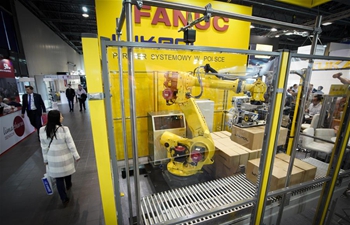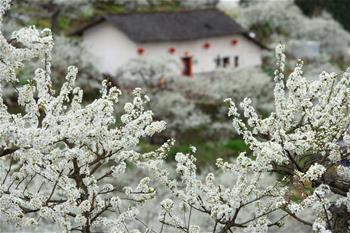CHICAGO, March 26 (Xinhua) -- Probiotics can evolve once inside the body and have the potential to become less effective and sometimes even harmful, according to a study by Washington University School of Medicine in St. Louis, U.S. state of Missouri.
The findings are published Tuesday in Cell Host and Microbe.
To study how the probiotic responds to different microbial communities, the researchers used mice that harbored four kinds of gut microbiomes, including no pre-existing bacteria, a limited set of bacteria, a normal microbiome and a normal microbiome after antibiotic treatment.
The researchers gave the mice the probiotic, and then varied the food the mice ate, giving them either mouse chow, high-fiber pellets that mimic the natural mouse diet; high-fat, high-sugar, low-fiber pellets meant to model typical Western eating habits; and Western pellets plus fiber. After five weeks, the researchers obtained the bacteria from the mice's guts and analyzed the microbes' DNA.
"In a healthy, high-diversity background we didn't capture a lot of adaptation, maybe because this is the background that Nissle is used to," said first research author Aura Ferreiro, a graduate student at the university. Nissle is a large granular body found in neurons.
But when the researchers studied a strain of Escherichia coli (E. coli) bacteria sold in Europe as an anti-diarrheal probiotic, they found that the bacteria's DNA changed and they developed new capabilities after living in mice's intestines for a few weeks. Under some conditions, the probiotics even turned on their hosts and acquired the ability to eat the protective coating on the intestine.
Destruction of this layer has been linked to irritable bowel syndrome. And the mice's diets and the make-up of their gut bacterial community influenced how much the probiotic evolved and in what ways.
"If we're going to use living things as medicines, we need to recognize that they're going to adapt, and that means that what you put in your body is not necessarily what's going to be there even a couple hours later," said senior author Gautam Dantas, a professor of pathology and immunology at the university. "There is no microbe out there that is immune to evolution.
"This isn't a reason not to develop probiotic-based therapies, but it is a reason to make sure we understand how they change and under what conditions," Dantas stressed.
The researchers then applied these findings to designing a potential probiotic therapy for phenylketonuria (PKU), a metabolic disorder that causes neurological damage. People with PKU are unable to break down phenylalanine, a protein building block found in many foods.
The researchers inserted a gene into Nissle that gave the bacteria the ability to degrade phenylalanine into a compound that is safely excreted in the urine. Then, they gave the bio-engineered bacteria to mice that lacked the capacity to metabolize phenylalanine. The next day, phenylalanine levels in some of the mice had dropped by half.
Moreover, the researchers did not find significant changes to the DNA of the engineered strain after one week of treatment, which suggests Nissle might be safe to use as a chassis for probiotic therapies over short time scales.













